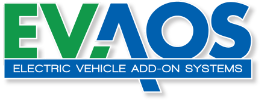Electric Vehicle Add-On Systems
Evolution
Technology Evolution
EVAOS has laid out a “technology evolution” plan that focuses on the following key technologies: Energy Storage Module (ESM), Electric Motor (EM), Drive Control Unit (DCU), Vehicle-to-Grid Module (V2G), Heavy Energy Storage Module (HESM), ESM Fuel Cell (ESM-FC), Partial Automation Kit (PA-1/PA-2), Conditional Automation Kit (CA-3), High Automation Kit (HA-4), and the Full Automation Kit (FA-5). It is our intent to evolve several generations of the technologies.
The technology evolution schedule, as well as the design, development, and production schedule for our currently envisioned product offerings, or for new product offerings, both nationally and internationally, can be accelerated or altered based on availability of funds, customer demands, and/or strategic developments.
EVAOS recognizes that quickening the pace of electrification commercialization lies in both reducing the cost of a HEV, PHEV, or EV offering, and by meeting and/or exceeding the customer’s performance, reliability, availability, and maintainability/serviceability requirements. Key to both is continued advances in batteries, electric motors, and controls. Of these three, none is more important than batteries.
EVAOS’s current product offerings use LiFeP04 (prismatic) cells. These cells have superior thermal and chemical stability, can handle higher temperatures without significant damage, have a higher rate of discharge, and relatively longer life cycles. They are also considered to be the safest chemistry. Although EVAOS anticipates use of next generation LiFePO4 cells, the Company remains open to using any cell chemistry. Our ESM requirements for our Class 2 through Class 8 offerings range from 10 kWh to greater than 500 kWh.
